国立嘉义大学九十六学年度第二学期「休闲教育与辅导」教学大纲
- 格式:doc
- 大小:128.50 KB
- 文档页数:20
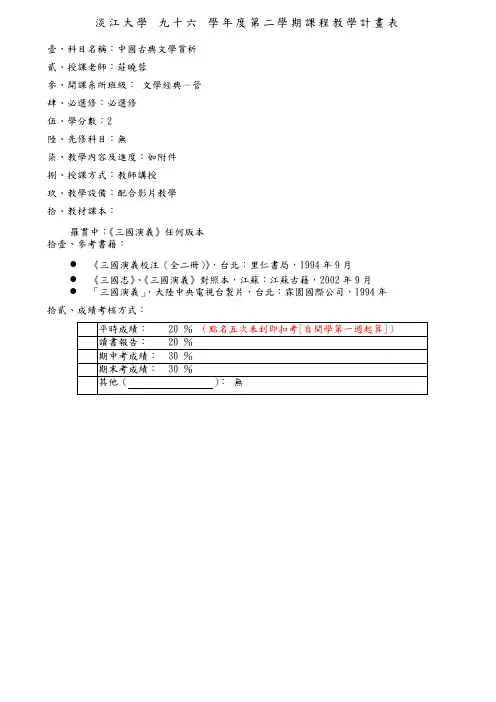
淡江大學九十六學年度第二學期課程教學計畫表
壹、科目名稱:中國古典文學賞析
貳、授課老師:莊曉蓉
參、開課系所班級:文學經典-管
肆、必選修:必選修
伍、學分數:2
陸、先修科目:無
柒、教學內容及進度:如附件
捌、授課方式:教師講授
玖、教學設備:配合影片教學
拾、教材課本:
羅貫中:《三國演義》任何版本
拾壹、參考書籍:
●《三國演義校注(全二冊)》,台北:里仁書局,1994年9月
●《三國志》、《三國演義》對照本,江蘇:江蘇古籍,2002年9月
●「三國演義」,大陸中央電視台製片,台北:霖園國際公司,1994年
拾貳、成績考核方式:
第四十二回橋,劉豫州敗走漢津口。
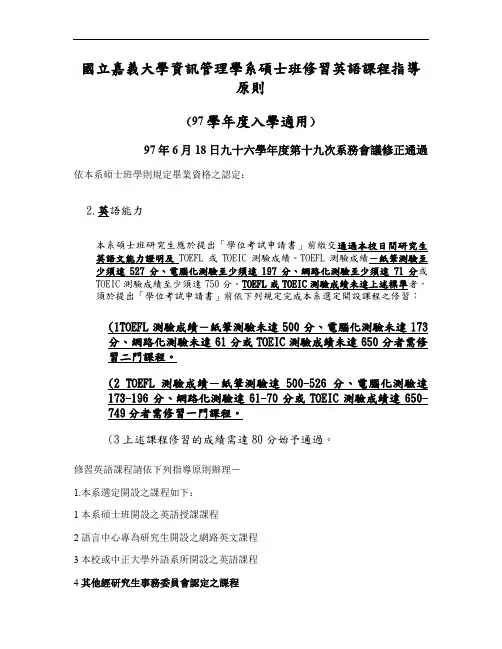
國立嘉義大學資訊管理學系碩士班修習英語課程指導原則(97學年度入學適用)97年6月18日九十六學年度第十九次系務會議修正通過依本系碩士班學則規定畢業資格之認定:2.英語能力本系碩士班研究生應於提出「學位考試申請書」前繳交通過本校日間研究生英語文能力證明及TOEFL或TOEIC測驗成績。
TOEFL測驗成績-紙筆測驗至少須達527分、電腦化測驗至少須達197分、網路化測驗至少須達71分或TOEIC測驗成績至少須達750分。
TOEFL或TOEIC測驗成績未達上述標準者,須於提出「學位考試申請書」前依下列規定完成本系選定開設課程之修習:(1TOEFL測驗成績-紙筆測驗未達500分、電腦化測驗未達173分、網路化測驗未達61分或TOEIC測驗成績未達650分者需修習二門課程。
(2 TOEFL測驗成績-紙筆測驗達500-526分、電腦化測驗達173-196分、網路化測驗達61-70分或TOEIC測驗成績達650-749分者需修習一門課程。
(3上述課程修習的成績需達80分始予通過。
修習英語課程請依下列指導原則辦理-1.本系選定開設之課程如下:1 本系碩士班開設之英語授課課程2 語言中心專為研究生開設之網路英文課程3 本校或中正大學外語系所開設之英語課程4 其他經研究生事務委員會認定之課程2.每門課程以取得單一學期學分為計算基準,不得重覆修習。
3.修習成績需達80分或以上始予通過。
4.有關前述”須於提出「學位考試申請書」前依下列規定完成本系選定開設課程之修習”之時程規定,如需二年畢業者,係指第二學年第一學期結束時即應修畢各課程並取得學期成績者方得完成資格之認定。
5.本指導原則如有未盡事宜,由系務會議研議決定之。

90 年 4 月25 日八十九學年度第二學期第三次系務會議通過依90 年8 月20 日九十學年度第一學期教育學院各研究所研究生論文指導相關事宜會議修正90年11月12 日九十學年度第一學期第二次系務會議修正通過92年10月15日九十二學年度第一學期第三次系務會議修正通過94年9月27日九十四學年度第一學期第二次系務會議修正通過95年6月20日九十五學年度第二學期第五次系務會議修正通過96年8月1日九十六學年度第一學期第一次系務會議修正通過96年12月4日九十六學年度第一學期第五次系務會議修正通過97年1月16日九十六學年度第一學期第六次系務會議修正通過98年1月7日97學年度第1學期第8次系務會議暨第5次課程發展委員會議修正通過98年9月30日98學年度第1學期第3次系務會議修正通過99年2月25日98學年度第2學期第1次系務會議通過99年8月27日99學年度第1學期第1次系務會議通過99年10月28日99學年度第1學期第3次系務會議通過一、依據:本系為規範研究生(含碩士在職專班研究生)修業相關事宜,依本校學則訂定國立嘉義大學幼兒教育學系碩士班課程修習要點(以下簡稱本要點)。
二、修業年限:(一)研究所碩士班修業年限1至4年,但在職進修研究生及碩士在職專班研究生未能在規定修業期限修滿應修課程或未完成學位論文者,得酌予延長修業期限1年;若學生因故申請休學,其休學累計以2學年為原則。
(二)前項在職進修研究生身分之界定,以入學時之報考身分為準,入學後欲申請身分變更者,得依本校研究生身分變更作業要點辦理。
三、碩士班課程學分數:(一)92至93學年度入學:1.必修課程12 學分及論文(論文不列入總學分)。
2.必選2 學分。
3.選修學分18 學分。
(二)94至96學年度入學:1.必修課程13 學分及論文(論文不列入總學分)。
2.必選2 學分。
3.選修學分17 學分。
(三)97學年度入學:1.必修課程15學分(論文不列入總學分)。
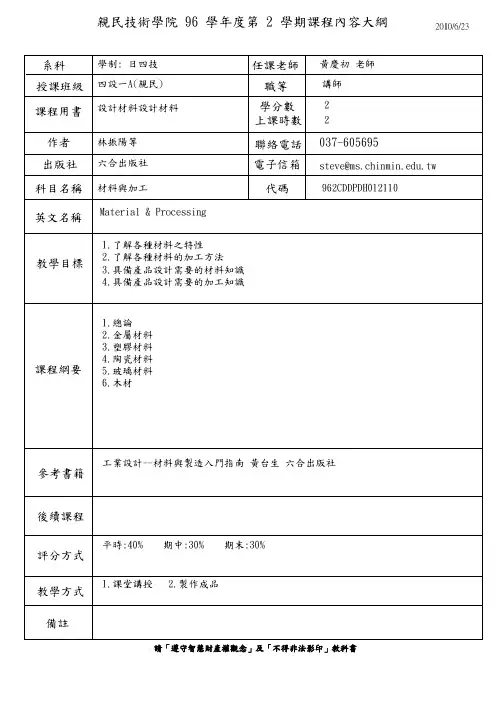
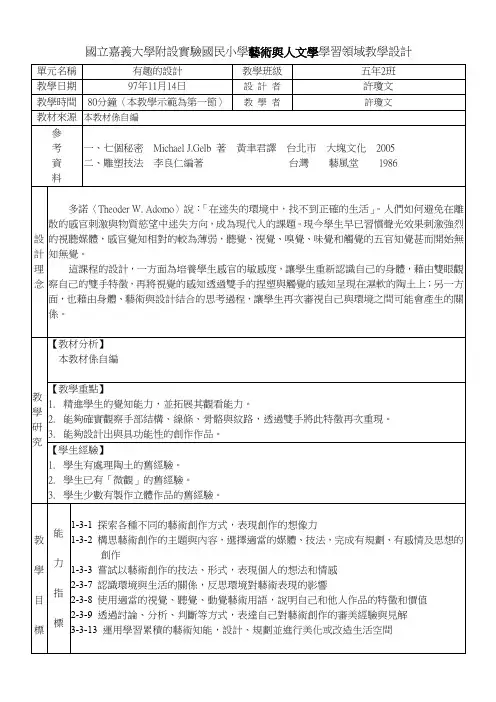
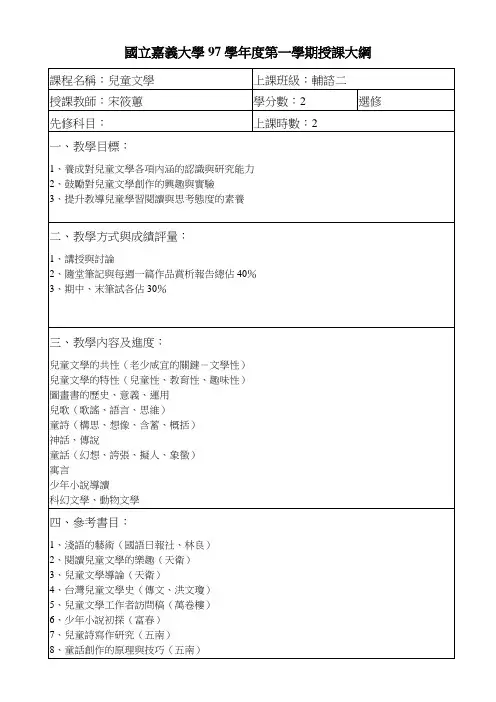
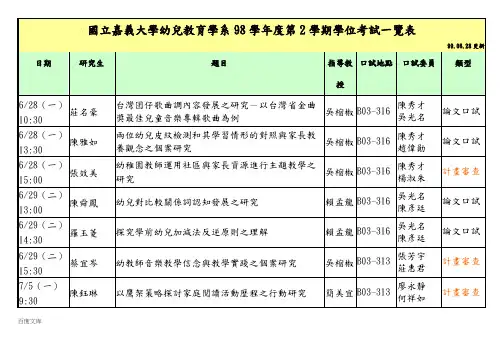
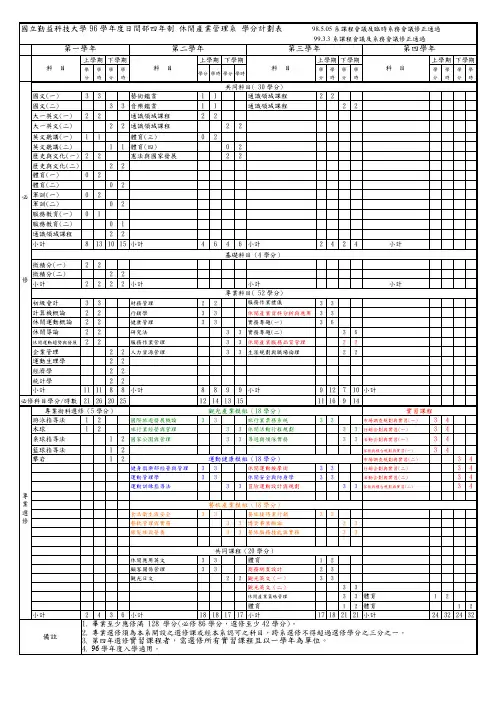

國立嘉義大學九十六學年度第二學期課程大綱科目名稱:諮商實習(下) 開課班級:輔導與諮商學系四年級授課教師:鄭翠娟、林本喬上課教室:B503學分時數:二學分\四小時必選修別:必修教學目標:1.統整輔導與諮商的理論與信念。
2.認識學校輔導的制度與組織。
3.瞭解中小學輔導室的設施與佈置。
4.知道學生資料的建立與應用方法。
5.學會擬訂各項輔導工作計劃。
6.練習處理個案的個諮與團諮技術。
7.熟知綜合活動領域教學的實施方法。
8.體認與實踐諮商倫理。
教學大綱:1.輔導與諮商的理論與技術 6.輔導活動的計劃與實施2.學校輔導工作的實施現況7.個諮與團諮的實施與技術3.學校輔導工作的制度與組織8.綜合活動領域的教學設計與實施4.中小學輔導室的設施與佈置9.輔導與諮商倫理的重要與實施5.學生資料的建立與運用10.輔導工作的資源與運用教學與評量方式:1.教師講授 1.讀書心得書面報告2.實務演練 2.個案報告3.個案討論 3.各項作業成績4.見習 4.輔導與諮商技術演練5.實習 5.學習精神與態度主要教材:1.宋湘玲等:(1985) 學校輔導工作的理論與實際. 復文書局。
2.吳武典:(1987) 國小怎樣實施輔導工作. 心理出版社。
3.吳武典編:(1980) 學校輔導工作. 張老師出版社。
4.陳李綢:(1991) 個案研究. 心理出版社。
5.馮觀富:(1990)國民中小學輔導與諮商理論實務.心理出版社。
6.鄭小萍:(1989) 國民小學輔導行政與實務. 編務文化公司。
7.黃惠惠:(1995) 助人歷程與技巧。
張老師文化出版公司。
8.林美珠、田秀蘭合譯:(2000) 助人技巧:探索、洞察與行動的催化。
學富文化公司。
9.陳金定:(2001) 諮商技術。
心理出版社。
10.鍾瑞麗譯:(2004) 助人歷程與技巧:有效能的助人者。
雙葉書廊公司。

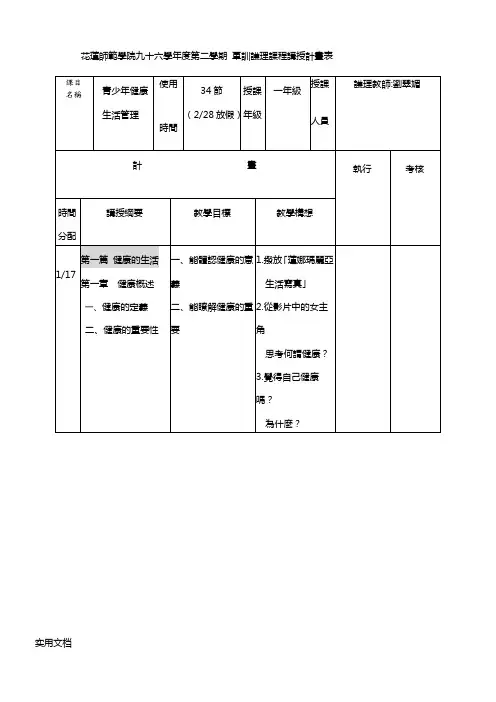
Teaching Plan for Semester One 2008Department of Early Childhood Education (BA Course)College of Teacher Education, National Chiayi UniversityCredit: 2 Class Hours:2 Classroom: B206Course Title:Young Children’s Drawings: Theory and PracticeCourse Time: Thursday 1:20~3:10Class:BA course Year 1Instructor:Yeh, Yu-ching (Associate Professor, Department of Early Childhood Education)Email: ycyeh@.tw Tel: (05)2263411 ext. 2211 1. Course ObjectivesChild art is the drawings, paintings and other artistic works created by people under the age of 12. The course contains theory of children’s art work and six practice work. This course will also provide the explanations of children’s thinking through their drawings and paintings.2. Course ScheduleWeek 1 IntroductionWeek 2 Practice 1: Clay Work (Personal Magnetic)Week 3 Drawings and Personal MentalityWeek 4 Drawing Analysis of Social Disadvantaged Children Week 5 Practice 2: Clay Work (Photo Frame)Week 6 Children’s Art Development (Year 1-5)Week 7 Children’s Art Development (Year 8-12)Week 8 How to create a rich environment with creativityWeek 9 Take young children to GalleryWeek 10 Practice 3: How to create an art work with naturalmaterials at campusWeek 11 Film & DiscussionWeek 12 Language instruction for children’s art workWeek 13 Practice 4: Children’s story book and creativityWeek 14 Instruction for children’s paintingWeek 15 Practice 5: Social studies in nursery education~ Mask Week 16 New Year HolidayWeek 17 Practice 6: Hand PrintWeek 18 Final Exam3. Assessments:(1) Art work in class (5 pieces of work): (75%)(2) Classroom Participation (25%)4. References:1.范瓊方(2006)。
國立嘉義大學九十六學年度第二學期「休閒教育與輔導」教學大綱課程代號: 0962 Y6400025 修別:選修學分:2授課教師:房兆虎課程名稱:休閒教育與輔導上課班級:大學部輔導諮商系一年級甲班上課時間:星期二1~2 上課教室:未設定(民雄校區)教學目標:1. 建立正確的休閒價值觀、休閒態度與培養休閒嗜好與技能。
世界休閒協會(World Leisure Association)所頒布的「休閒憲章(Charter for Leisure)」(2000年)提到:一、所有的人都有休閒基本人權;二、政府應確保人民容易獲得最高品質的休閒與遊憩機會……而如何落實提供大眾「休閒權」,是目前政府與民間所應關注的課題。
雖然國內已掀起一片休閒熱,但因「休閒能力」不足,也導致個人或社會產生諸多問題。
值得關注的議題包括:休閒是否需要教育?休閒的目標、成效又是如何?在學校體制與非教育機構如何實施?休閒治療方案如何介入個案之輔導歷程?特殊個案之休閒訓練模式2. 肯定「休閒」對提升生活品質的重要性。
首先要改變「休閒」觀念,從過去負面的評價,如「怠惰」、「閒散」或「不事生產」,轉變為「提升生產力」或「紓解身心壓力」等正向評價,進而肯定「休閒使生命更豐碩」的觀點,故休閒領域得以拓展。
如休閒農業、休閒漁業、休閒服、休閒鞋、休閒食品、休閒屋、休旅車、休閒廣場、休閒週報……可見,休閒已不再是有錢人的專利,而是每個人的生活「主流價值」之一。
3. 了解「休閒治療」(Therapy Recreation)領域,以增進輔導專業能力,拓展輔導專業生涯。
參閱Dolphin therapy: recreation or medicine?Recreational Therapy: An Integral Aspect of ComprehensiveHealthcare.U.S. Department of Labor Bureau of Labor Statistics RecreationalTherapists.一、教學與評量:(一)教學方式:1.引言與討論2.輔導與諮商選文導讀3.專題寫作與報告(二)評量:1.課堂參與15%2.專題寫作並展示成果報告35%(1)分組專題報告(依指定專題,以組為單位,完成專題)(2)個人專題寫作3.期中考25%4.期末考25%二、課程進度與大綱週次日期內容主題參閱書籍與資料(一)2月19日課程簡介、文選導讀(Dolphin therapy: recreation ormedicine?)(二)2月26日文選導讀U.S. Department of Labor Bureau of Labor StatisticsRecreational Therapists(三)3月4日文選導讀(Recreational Therapy: An Integral Aspect ofComprehensive Healthcare)(四)3月11日幸福人生與休閒、休閒與工作(五)3月18日休閒與我、休閒與人際社會(六)3月25日身心發展與休閒(七)4月1日人生=業餘愛好+工作(八)4月8日複習(九)4月15日期中考(十)4月22日五花八門的業餘愛好(十一)4月29日如何培養愛好(十二)5月6日休閒與休憩資源(十三)5月13日生態旅遊與休閒(十四)5月20日探索教育與休閒(十五)5月27日專題報告與分享(十六)6月3日專題報告與分享(十七)6月10日專題報告與分享(十八)6月17日期末考四、教材與參考資料(一)涂淑芳譯Cene Bammel & Lei Burrus-Bammel 著休閒與人類行為桂冠(二)休閒社會學Sociology of leisure 李力昌偉華出版, 臺北: 2005[民94] (三)休閒社會學史托柯夫斯基吳英偉陳慧玲五南, 台北民85(四)休閒活動設計規劃The process of leisure programming 吳松齡揚智文化, 2006[民95](五)休閒研究: 休閒觀與休閒專論葉智魁品度,2006[民95](六)休閒活動對在學青少年行為之影響及輔導策略之研究嚴祖弘賴志超黃世明行政院青年輔導委員會: 正中經銷, 民90(七)休閒教育訓練手冊貝克-福特布朗顏妙桂: 帅獅,2004[民93](八)治療式遊憩導論David R. Austin Michael E. Crawford原著陳俊忠、姜義村、林春鳳、杒淑芬、劉以德、張心怡、何立安等譯品度股份有限公司五、分組專題報告的主題方向(一)國小階段少年的休閒活動與休閒輔導及休閒輔導方案設計(二)國中階段青少年的休閒活動與休閒輔導及休閒輔導方案設計(三)高中階段青少年的休閒活動與休閒輔導及休閒輔導方案設計(四)大專學生的休閒活動與休閒輔導及休閒輔導方案設計(五)身心障礙者休閒教育與輔導方案設計(六)高齡者休閒運動保健、休閒輔導方案設計(七)休閒農業與休閒農場在休閒治療上的應用與設計(八)才藝與技能在休閒輔導上的應用與設計(九)主題旅遊在休閒輔導上的應用與設計六、個人專題研究與寫作(一)自訂題目(須與休閒教育與輔導有關聯)(二)以閱讀專書、研究報告作為寫專題心得之體裁、或自編問卷調查寫歷程與研究結果為內容(三)寫作格式要符合論文格式(參閱國內論文發表的格式)七、網路資源(一)救國團探索教育中心.tw/se/Documents/HTM/Fellowship.htm(二)台灣生態旅遊網.tw/d1.htm(三)International Dolphin watch helps Dolphins and people/index.html八、文選導讀:Dolphin therapy: recreation or medicine?March 28, 1998Web posted at: 6:27 p.m. EST (2327 GMT)MIAMI (CNN) -- An 8-year old British boy trapped in a world of silence since birth recently uttered his first word after an intense, three-day therapy session with dolphins, his physician says.Doctors at the Human Dolphin Therapy Center in Miami believe the highly intelligent creatures have the extraordinary ability to help treat children with autism, Down syndrome and other neurological and movement disorders.Dr. David Nathanson, director of the center, considers Nikki Brice one of the successes."I said, ... 'All right, Nick, do you want to get in the water?' And he shook his head yes and put his foot from the dock into the water, and took his foot back.CNN's Porter Andersonreports"And I said, 'No, Nick, you have to say in,' and he looked at me and he said 'in.' "I said,'Let's hear it a little clearer, please.'"And I put my hands to his face like this, and he said 'in.'While the therapy has attracted supporters, many scientists remain skeptical.Mother says son has been helpedBriton Billy Bayles, who has communication and learning difficulties triggered by a chromosome abnormality, also is a patient at the center, but he has yet to speak.With the help of donation s from their hometown of Southampton, his parents raised $10,000 to bring the 8-year-old to the center.He spends 40 minutes every day undergoing speech and communication therapy, a large part of which is interacting with the dolphins. The goal is to let them encourage and stimulate Billy so he can focus on learning to speak.Billy's mother already has noticed an improvement."He's trying to do more signs, because we do a lot of sign language with him so that we can give him another alternative way of communicating with us. And he's actually done a couple of signs which he's not done before," Andrea Bayles said.How does the process work?Some medical professionals admit that dolphins can have a therapeutic effect on people suffering from depression and learning difficulties. But doctors are baffled as to how the process works.One theory is that dolphins use their unique sonar ability to identify neurological disorders in people, then help them relax and open up to learning and healing."These kids gain a tremendous sense of confidence because they've actually, measurably, quantifiably improved," Nathanson said.(187 K / 17 sec. AIFF or WAV sound)But many scientists argue that the children just like the feel of the dolphins, and it is no more than a recreational pastime.And they note that there are no comprehensive studies on dolphin therapy to prove it really works.Doctors at the dolphin therapy center claim they have helped more than 1,000 children overcome learning disorders, and say that represents a 97 percent success rate.Recreational Therapy:An Integral Aspect ofComprehensive HealthcareThe American Therapeutic Recreation Association, the largest national organization representing recreational therapy professionals, has prepared this statement to facilitate the understanding of the critical role recreational therapists play in comprehensive healthcare and to facilitate the recognition of thecost-effective nature of utilizing recreational therapy services to ensure the total rehabilitation and quality of life for persons with disabilitiesWhat is recreational therapy?Recreational therapy, also referred to as therapeutic recreation, is defined by the United States Department of Labor as a profession of specialists who utilize activities as a form of treatment for persons who are physically, mentally or emotionally disabled (Paraphrased, Occupational Outlook Handbook, U.S. Department of Labor, Bureau of Labor Statistics, April 1991). Differing from diversional or recreation services, recreational therapy utilizes various activities as a form of active treatment to promote the independent physical, cognitive, emotional and social functioning of persons disabled as a result of trauma or disease, by enhancing current skills and facilitating the establishment of new skills for daily living and community functioning.Who delivers recreational therapy services?Recreational therapy services are delivered by qualified professionals with training and education in therapeutic recreation/recreational therapy service delivery and professionally certified by the National Council for Therapeutic Recreation Certification (NCTRC).The professional certification designation is Certified Therapeutic Recreation Specialist (CTRS). The credential requires a bachelor's degree or higher from an accredited institution of higher education in the area of therapeutic recreation (recreational therapy), an approved internship under the supervision of a professionally credentialed CTRS, and the passing of a national certification examination administered for the NCTRC by the Educational Testing ServiceWhat is the projected demand for recreational therapy?According to the United States Department of Labor's 1994 Occupational Outlook Handbook, "Employment of recreational therapists is expected to grow faster than the average for all occupations through the year 2005, because of the anticipated expansion in long-term care, physical and psychiatric rehabilitation, and services for the disabled." There are over 30,000 employment positions in the United States and the growth rate is projected at 40% through the year 2005. It is important to note that employment is available in a wide variety of settings, working with individuals with varying types of disabilities and illnesses.Where are recreational therapy services delivered?Recreational therapy services are delivered in a variety of settings depending on the needs of the consumer. Settings in which services are traditionally delivered include freestanding rehabilitation hospitals, rehabilitation units in general hospitals,long-term care, subacute care, or skilled nursing facilities, substance abuse rehabilitation facilities, home healthcare services, and residential facilities for persons with disabilities.What are the benefits of recreational therapy services?Research indicates that recreational therapy services, provided by qualifiedprofessionals, offer a diversity of rehabilitation benefits addressing the needs of individuals with a range of disabling conditions. A recent conference, sponsored by Temple University and funded through the National Institute on Disability and Rehabilitation Research (NIDRR), evaluated the efficacy of therapeutic recreation services as a treatment modality on rehabilitation outcomes. Research has demonstrated the value of recreational therapy services for individuals with a range of diagnoses.Recreational therapy is a component of comprehensive rehabilitation. Such comprehensive rehabilitation services have proven to be cost-effective. A survey conducted by the Health Insurance Association of America indicated a savings of $11 for every $1 spent on rehabilitation. In addition, other studies have indicated that quality comprehensive rehabilitation services reduce long-term hospitalization and nursing home stays for stroke patients and thus save the American economy $17,000 per year per patient. Recreational therapy services play a significant role in comprehensive efficient healthcare systems.∙Recreational therapy services are an effective means for improving the functioning, independence, and quality of life of persons with illness ordisability. The provision of recreational therapy services, in concert withrelated disciplines such as occupational therapy, physical therapy andspeech therapy, offer the client or patient comprehensive rehabilitationservices. The proper mix of services and the therapist-client relationshipproves to be of maximum benefit to the consumer.∙Well managed and cost effective services are an investment in human potential. Recreational therapy services utilize both individual and smallgroup intervention strategies, therefore, staff/patient ratios arecost-effective. More patient treatment hours per therapist can be generated through the use of such small group interventions. Furthermore, recreational therapy services for older Americans are equally cost-effective. Recreational therapists play a significant role in assisting older adults to maintain current skills and re-establish previous levels of functioning in the least restrictiveenvironment possible. Recreational therapists work in concert with andprovide complement to other treatment modalities.∙Recreational therapy plays a primary role in enhancing the quality of life and productivity of the consumer. Enjoyable activities and social relations aresignificant in promoting he quality of life and productivity of the individualwith a disability. Recreational therapists offer individuals with disabilities the opportunity to resume normal life activities and to establish/re-establishskills for successful social integration. In addition, the therapist will employ treatment modalities which promote physical skill development, enhancefeelings of well-being, foster successful experiences, facilitate continuedinvolvement in the rehabilitation process, and establish new life activities for continued growth.Utilization of Recreation Therapy Services as a Standard Service in Managed Healthcare SystemsRecreational therapy as a member of the core rehabilitation treatment teamRecreational therapy is listed as one of the physical rehabilitation services in the Joint Commission on Accreditation of Healthcare Organizations (JCAHO) standards. Recreational therapists are standard treatment team members in psychiatric rehabilitation, substance abuse treatment, and physical rehabilitation services. In addition, recreational therapists are designated as members of the comprehensive core treatment team in the acute brain injury, the post-acute brain injury, and the inpatient rehabilitation standards of the Commission on Accreditation of Rehabilitation Facilities (CARF) Since the 1940's, recreational therapists have served as active members of the interdisciplinary treatment team addressing the psychosocial and physical rehabilitation needs of the consumer. Recreational therapy will certainly have an active role in a managed care and managed competition system with emphasis on providing opportunities for meeting rehabilitation goals, accessing life skills and opportunities, and providing quality services in the most cost-efficient manner. These functions must be performed on an on-going basis in concert with other allied health fields such as physical therapy, occupational therapy, and speech therapy and audiology. Although some overlap occurs between all disciplines in area such as activities of daily living, vocational and avocational adjustment, and application of motor performance skills in the natural environment, the disciplines mutually complement each other in the rehabilitation environment. For instance, each discipline may work on the development of physical skills and activities of daily living. Much of the responsibility for community adjustment and integration efforts in the rehabilitation setting, however, has become the charge of the recreational therapist. In addition, recreational therapists assist the consumer in developing or re-developing social skills, discretionary time skills, decision making skills, coping abilities, self-advocacy, discharge planning for re-integration, and skills to enhance general quality of life. As with each allied health discipline, treatment goals are based upon individual needs. The ability to meet thephysical and psychosocial needs of the person affected by a disability is critical to the pursuit of independent productivity in vocational and avocational endeavors.Recommendations in Healthcare AllocationsThe American Therapeutic Recreation Association is in support of a healthcare allocations package which ensures coverage for all Americans. This package should include cooperative efforts between public and private health insurance programs. The healthcare package should also include standard coverage of a range of rehabilitative services including recreational therapy services. Current practices restrict the range of rehabilitation services that are identified as standard reimbursable services under Part A of the Medicare and Medicaid Guidelines (e.g. physical therapy, occupational therapy, speech therapy and respiratory care.) Through inclusion and utilization of recreational therapy services under Part A and Part B of the Medicare and Medicaid Guidelines, the healthcare provider will have access to additional options to meet the treatment needs of the consumer. The availability of a broader base of outcome oriented therapies and the application of a proper combination of therapeutic modalities will offer several dramatic benefits:∙ The specific needs of the consumer can be better met with the greater availability of disciplines.∙Proper mixes of therapies in a managed care and managed competition system offers a more cost-effective means to meet consumer needs.∙This approach responds in the most effective and efficient manner to the critical shortage of healthcare practitioners by expanding the pool ofavailable professionals.The utilization of recreational therapy offers an opportunity for accessing these treatment options to meet the "personal assistance services" of the healthcare consumer. This approach would provide expanded options and service mixes which will prove more cost-effective. For instance: At the current time, if an individual is receiving rehabilitation services for a cerebral vascular accident (stroke), the individual will likely be involved in 1:1 (one on one) physical therapy services to improve range of motion. Should there be an option of inclusion of recreational therapy services (frequently prescribed in group format), the person could receive 60% physical therapy 1:1 services and 40% recreational therapy services in aquatic therapy groups. The result is a mix that is in the best interest of the consumer and will prove to be more cost-effectiveConclusionIn conclusion, the American Therapeutic Recreation Association is in support of cost-effective healthcare opportunities for all citizens. The growing need to ensure basic services to all of America's citizens is evident. The number of Americans requiring health and rehabilitation services continues to increase due to an aging population, disabling conditions, improved treatment services, and greater survival rates. The need to access a broad range of services, therefore is crucial. The intent should be the utilization of effective treatment options as standard services within a healthcare program. Recreational therapy should be included as a viable option to meet the needs of consumers with disabilities. Ultimately, the availability of managed healthcare options which respond to the unique treatment needs of individuals with disabilities will prove cost-effective. Inclusion of a comprehensive system that responds to individual healthcare consumer needs will reduce the length of hospital stay, reduce hospital recidivism, and maximize on the productivity of the individual. Recreational therapy has been and should continue to be included as an effective treatment discipline in the provision of quality, cost-effective healthcare services.U.S. Department of LaborBureau of Labor StatisticsRecreational TherapistsNature of the WorkWorking ConditionsTraining, Other Qualifications, and AdvancementEmploymentJob OutlookEarningsRelated OccupationsSignificant PointsOverall employment of recreational therapists is expected to grow more slowly than the average for all occupations, but employment of therapists who work in community care facilities for the elderly and in residential mentalretardation, mental health, and substance abuse facilities should grow faster than the average.Opportunities should be best for persons with a bachelor degree in therapeutic recreation, or in recreation with a concentration in therapeuticrecreation.Recreational therapists should be comfortable working with persons who are ill or who have disabilities.NATURE OF THE WORKRecreational therapists, also referred to as therapeutic recreation specialists, provide treatment services and recreation activities to individuals with disabilities or illnesses. Using a variety of techniques, including arts and crafts, animals, sports, games, dance and movement, drama, music, and community outings, therapists treat and maintain the physical, mental, and emotional well-being of their clients. Therapists help individuals reduce depression, stress, and anxiety; recover basic motor functioning and reasoning abilities; build confidence; and socialize effectively so that they can enjoy greater independence, as well as reduce or eliminate the effects of their illness or disability. In addition, therapists help integrate people with disabilities into the community by teaching them how to use community resources and recreational activities. Recreational therapists should not be confused with recreation workers, who organize recreational activities primarily for enjoyment. (Recreation workers are discussed elsewhere in the Handbook.)In acute health care settings, such as hospitals and rehabilitation centers, recreational therapists treat and rehabilitate individuals with specific health conditions, usually in conjunction or collaboration with physicians, nurses, psychologists, social workers, and physical and occupational therapists. Inlong-term and residential care facilities, recreational therapists use leisure activities—especially structured group programs—to improve and maintain their client’s general health and well-being. They also may provide interventions to prevent the client from suffering further medical problems and complications related to illnesses and disabilities.Recreational therapists assess clients on the basis of information the therapists learn from standardized assessments, observations, medical records, the medical staff, the client’s families, and the clients themselves. They then develop and carry out therapeutic interventions consistent with the client’s needs and interests. For example, clients who are isolated from others or who have limited social skills may be encouraged to play games with others, and right-handed persons with right-side paralysis may be instructed in how to adapt to using their unaffected left side tothrow a ball or swing a racket. Recreational therapists may instruct patients in relaxation techniques to reduce stress and tension, stretching and limbering exercises, proper body mechanics for participation in recreational activities, pacing and energy conservation techniques, and individual as well as team activities. In addition, therapists observe and document a patient participation, reactions, and progress.Community-based recreational therapists may work in park and recreation departments, special-education programs for school districts, or programs for older adults and people with disabilities. Included in the last group are programs and facilities such as assisted-living, adult day care, and substance abuse rehabilitation centers. In these programs, therapists use interventions to develop specific skills, while providing opportunities for exercise, mental stimulation, creativity, and fun. Although most therapists are employed in other areas, those who work in schools help counselors, teachers, and parents address the special needs of students, including easing disabled student’s transition into adult life.WORKING CONDITIONSRecreational therapists provide services in special activity rooms, but also plan activities and prepare documentation in offices. When working with clients during community integration programs, they may travel locally to instruct the clients regarding the accessibility of public transportation and other public areas, such as parks, playgrounds, swimming pools, restaurants, and theaters.Therapists often lift and carry equipment, as well as lead recreational activities. Recreational therapists generally work a 40-hour week that may include some evenings, weekends, and holidays.TRAINING, OTHER QUALIFICATIONS, AND ADVANCEMENTA bachelor degree in therapeutic recreation, or in recreation with a concentration in therapeutic recreation, is the usual requirement for entry-level positions. Persons may qualify for paraprofessional positions with an associate degree in therapeutic recreation or a health care related field. An associate degree in recreational therapy; training in art, drama, or music therapy; or qualifying work experience may be sufficient for activity director positions in nursing homes.Approximately 150 programs prepare students to become recreational therapists. Most offer bachelor degrees, although some also offer associate, master , ordoctoral degrees. Programs include courses in assessment, treatment and program planning, intervention design, and evaluation. Students also study human anatomy, physiology, abnormal psychology, medical and psychiatric terminology, characteristics of illnesses and disabilities, professional ethics, and the use of assistive devices and technology.Although certification is usually voluntary, most employers prefer to hire candidates who are certified therapeutic recreation specialists. The National Council for Therapeutic Recreation Certification is the certificatory agency. To become certified, specialists must have a bachelor degree, pass a written certification examination, and complete an internship of at least 480 hours. Additional requirements apply in order to maintain certification and to recertify. Some States require licensure or certification to practice recreational therapy.Recreational therapists should be comfortable working with persons who are ill or who have disabilities. Therapists must be patient, tactful, and persuasive when working with people who have a variety of special needs. Ingenuity, a sense of humor, and imagination are needed to adapt activities to individual needs, and good physical coordination is necessary to demonstrate or participate in recreational activities.Therapists may advance to supervisory or administrative positions. Some teach, conduct research, or consult for health or social services agencies.EMPLOYMENTRecreational therapists held about 24,000 jobs in 2004. About 6 out of 10 were in nursing care facilities and hospitals. Others worked in State and local government agencies and in community care facilities for the elderly, including assisted-living facilities. The rest worked primarily in residential mental retardation, mental health, and substance abuse facilities; individual and family services; Federal Government agencies; educational services; and outpatient care centers. Only a small number of therapists were self-employed, generally contracting with long-term care facilities or community agencies to develop and oversee programs.JOB OUTLOOKOverall employment of recreational therapists is expected to grow more slowly than the average for all occupations through the year 2014. In nursing care facilities—the largest industry employing recreational therapists—employment will grow slightly faster than the occupation as a whole as the number of older adults continues to grow. Employment is expected to decline, however, in hospitals asservices shift to outpatient settings and employers emphasize cost containment. Fast employment growth is expected in the residential and outpatient settings that serve disabled persons, the elderly, or those diagnosed with mental retardation, mental illness, or substance abuse problems. Among these settings are community care facilities for the elderly (including assisted-living facilities); residential mental retardation, mental health, and substance abuse facilities; and facilities that provide individual and family services (such as day care centers for disabled persons and the elderly). Opportunities should be best for persons with a bachelor degree in therapeutic recreation or in recreation with an option in therapeutic recreation. Opportunities also should be good for therapists who hold specialized certifications, for example, in, aquatic therapy, meditation, or crisis intervention.Health care facilities will support a growing number of jobs in adult day care and outpatient programs offering short-term mental health and alcohol or drug abuse services. Rehabilitation, home health care, and transitional programs will provide additional jobs.The rapidly growing number of older adults is expected to spur job growth for recreational therapy professionals and paraprofessionals in assisted-living facilities, adult day care programs, and other social assistance agencies. Continued growth also is expected in community residential care facilities, as well as in day care programs for individuals with disabilities.EARNINGSMedian annual earnings of recreational therapists were $32,900 in May 2004. The middle 50 percent earned between $25,520 and $42,130. The lowest 10 percent earned less than $20,130, and the highest 10 percent earned more than $51,800. In May 2004, median annual earnings for recreational therapists were $28,130 in nursing care facilities.RELATED OCCUPATIONSRecreational therapists primarily design activities to help people with disabilities lead more fulfilling and independent lives. Other workers who have similar jobs are occupational therapists, physical therapists, recreation workers, and rehabilitation counselors.休閒反被視為一種必要的人權:19從休閒價值觀談休閒不動產的發展趨性黃勝雄在歷史的某些階段,「休閒」曾被視為負面的、消極的、甚至罪惡的,例如Thorstein Veblen 在1899 年的著作「休閒階級論」(The Theory of the。